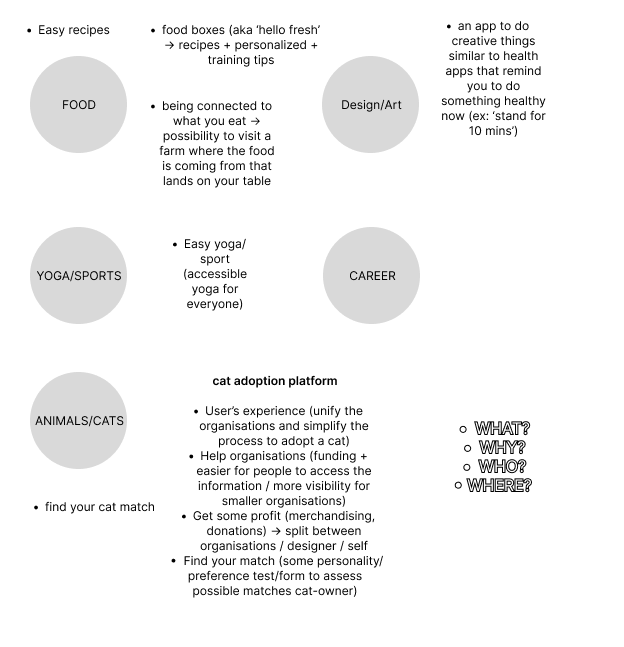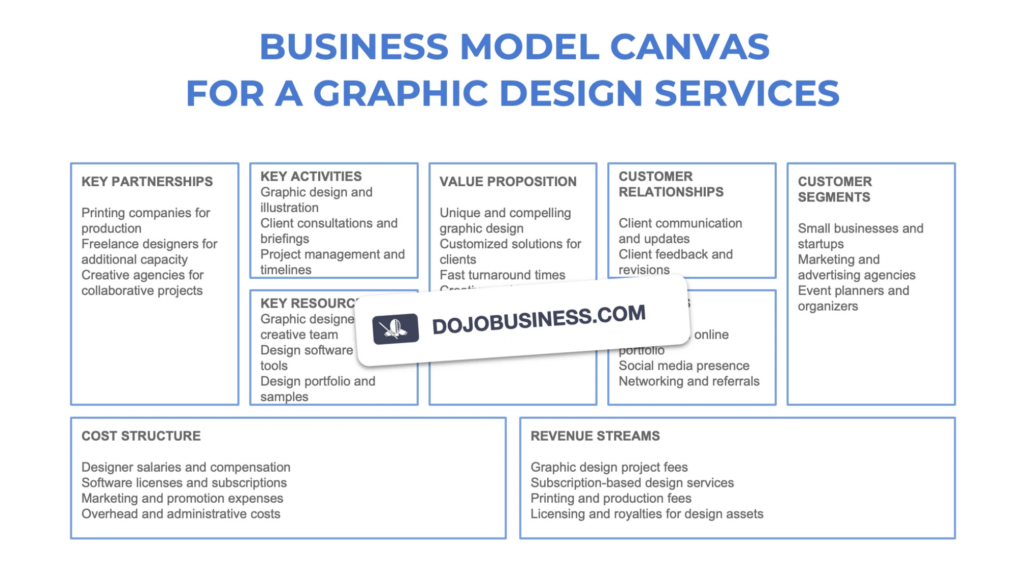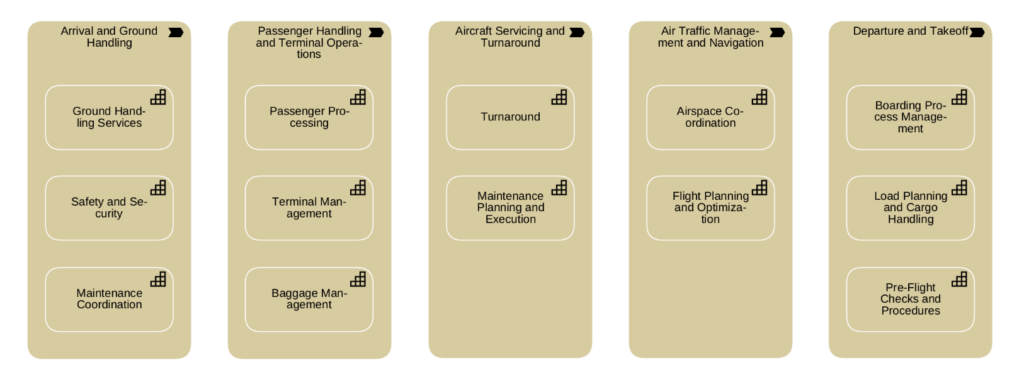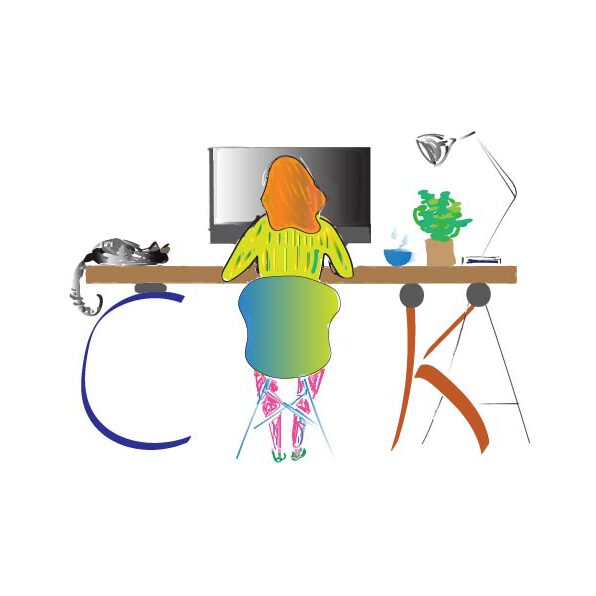Week 2
- I started brainstorming about my business idea
I had several first ideas:

- The research tasks for week 2 were tough ones ->
1. Research some of the core operational aspects of a design studio or freelance business
The Operating Model of a business
I haven’t had any exposure to the core aspects or workings of a business, let alone a design studio or freelance work. But if you start telling people that this is the case, maybe someone knows someone who has experience and can help. Firstly, I want to be clear about what my business is about and what the key operational aspects are. Firstly, in my search for operational aspects (in a design company, a freelancer) I haven’t found much information. Eventually, I found an informative article saying an operational model is “describing how various organizational components [of a business] collaborate to deliver customer value and achieve company objectives” (https://www.boc-group.com/en/blog/ea/how-to-design-a-target-operating-model/). It also mentions the Business canvas model to get started, that I’ve seen mentioned in several other sources as well. The Business model canvas is a strategic management tool, which is structured in table format and helps visualising and developing business models.
I found several examples, some are behind a paywall.

Source: https://dojobusiness.com/blogs/news/graphic-designer-business-model-canvas
The Value Chain Analysis analysis by Michael Porter “identifies and optimizes primary and support activities that create customer value” (https://www.boc-group.com/en/blog/ea/how-to-design-a-target-operating-model/)

Source: https://www.boc-group.com/en/blog/ea/how-to-design-a-target-operating-model/
It can also be beneficial to look at a company’s environment to identify possible influences. The PESTLE analysis looks at the external (political, economic, technological, legal, social and environmental) environment and then “informs strategic decisions and adjustments to align the operating model with external influences.” (https://www.boc-group.com/en/blog/ea/how-to-design-a-target-operating-model/)
When looking at the operational aspects of a company, I have also found sources that tend to describe the micro-processes in a company when it comes to how people work and collaborate.
- “Organizational Design focuses on the arrangement of roles, responsibilities, and relationships within the organization. It establishes formal hierarchies and structures that determine task allocation, reporting lines, and facilitate coordination and collaboration… The operating model specifies what needs to be done to deliver value, while organizational design determines how individuals within the organization are organized to accomplish these objectives.” (https://www.boc-group.com/en/blog/ea/how-to-design-a-target-operating-model/)
At the organizational level, design typically involves the arrangement of activities, roles, or positions within the organization to efficiently (and potentially in innovative ways) manage the interdependencies that are present. In terms of the business model, design can be viewed as the specific (and possibly new) configuration of activities facilitated by business model stakeholders and the resources they utilize. (Strategic Design of Innovative Business Models, p. 133)
- Design Operations (source: https://blog.yess.io/what-is-the-design-operations-process/): …”is connected to the concepts of Operational Design. These core principles aim to enhance the efficiency of design-related tasks. This encompasses everything from “Functional Design Operations” to “Operations Design Techniques.” Over time, the approach expanded to include broader aspects like “Design Processes Management” and “Design Execution Strategies.” This shift represented a pivotal moment in the development of Design Operations, elevating it from a simple operational toolkit to a vital strategic resource. Today, Design Operations incorporates the ideas of “Strategic Design Planning” and “Advanced Operational Design.” It is a lasting strategy that integrates seamlessly with “Design Management Principles” to become an integral part of an organization’s framework.”
2. Research how to map out a hypothetical resourcing model for a new business which utilises your unique design expertise
This task is not yet complete, although I think it is fair to say that the resources (section: key resources) are mapped in the business canvas model. It can be tools like software but also the team itself is a resource (ustwo design agency: “in larger studios we have resourcing managers who know who’s on what project. Usually each person has one project”)
Although I think this task needs a bit more time and starting with the business plan will probably help to think about it.
Lecture
This week’s lecture showed different studios and also one freelance designer, how they work and their business structure. Don’t work with bigger clients usually (but bigger clients bring more money)
- Studio Moross by Kate Moross
- In general: discourage overwork (35hrs/week); enjoy personal lives & clients & work; support staff and listen to their needs; actively challenge & address structural inequalities within design industry; mentor and advise individuals & new companies
- some people are on several projects at the same time
- adjust taking projects based on if budget in a month is met or not
- Fee structure & Jobs they take:
- Pro-Rata Jobs: Staff payed for every hour/min; Rates between 25 – 60h (pound)
- calculated by salary + costs + profit
- Fixed Rate Jobs
- Jobs with budget (client based)
- Be accurate not to go over budget
- pro-rata rates to calculate job costs
- Silly Money Jobs
- big brand jobs which are not reflective of hours
- high usage / exposure (ads, brand collab)
- Jobs they loose money
- charity
- swaps
- trades/favors for people
- projects/people they support
- Neef Rehman from ustwo
- scale they operate usually requires long process with bigger clients
- Mission: Launch products, services and companies that have a meaningful impact on the world
- clients, ownIP (invest in companies that do impactful/creative work), ventures: first 10 yrs. was mainly client work, now also experimenting with other ways to leverage in-house talent
- 3 departments:
- Studios:
- agency model (clients); profitable early on (not having many investors and not owned by large consultancy firm)
- projects: discovery (research), design and build (software development)
- each team includes clients and coaches (=PM & ensures smoothness and education happening on client and own staff site)
- learning together in the job (client and internal teams)
- Games
- own ip – not working with clients
- create and sell games
- high upfront cost but high reward
- most noteworthy projects – profile building
- Adventure
- investment fund: invest in creatively aligned companies
- alternative structure
- don’t take equity in business – see value in financial independence -> work with businesses to invest capital & engage in revenue share agreement
- maintains creative focus
- Adventure <-> Studios exchange and support
- Studios:
- Goal -> Diversification -> be resilient with different revenues
- => take risks, operate in different structures, maintain culture with a different model
- Lisa Armstrong from Lovers
- international collective working only on projects they love
- small core team that provides creative direction and project management support
- project tracker (designed by themselves): communicates resource usage and logs team/client happiness => instead of sending lengthy emails to client => logs happiness of client and team
- Theo Inglis – Freelancer
- freelance is usually:
- in-house (day-rate; agent sometimes; big studios; design focused)
- independent (studio of one; own clients; fee/project; freedom)
- lessons learned:
- put yourself out there
- good can come from bad
- work leads to more work
- look for people who need you
- build relationships
- niches are good
- panel discussion with the designers from above:
- Most business in UK is repeat business (people come back to work with you again if they liked the cooperation)
- changes in the kind of work they do?
- ustwo: Adapt to what’s currently trendy/tech
- Kate Moross: Sometimes it’s good to be new in a field you have not worked in before to bring in a new perspective
- Advice for people who want to build a business?
- ustwo: When starting really identify your niche and stay true to it
- Lisa: Instill trust in all people around you – build strong relationships
- Theo: As independent designer have something on the side like a long term project you can work on when it’s downtime (personal stuff etc.)
Other Resources
How clients want to be treated: in AIGA professional practices in graphic design by David C. Baker (book chapter)
4 components of relationship management:
-Marketing: clients come for specific reasons; attract them for the right reasons (knowing what you are doing) and keeping them for other reasons (knowing how to treat them)
-Formalizing: defining the relationship carefully to cause ‘service’ issues to surface early -> written agreements
-Servicing
-Listening: a complaint can be a gift – consistent, systematic feedback gathering from clients
The process of setting fees: in AIGA professional practices in graphic design by Eva Doman Bruck (book chapter)
Process of setting fees:
- cost of staying in business (overhead)
constant costs -> rent, utilities, equipment leases, office supplies, business insurance, salaries, taxes & benefits, accounting & legal services, cost of non-billable time for self-promotion & adminstrative costs
hourly rate = Annual overhead (salary + profit) / Annual Billable Hours
- best estimate of nature and complexity of the project (variable costs)
- knowing intrinsic value of final product (market conditions) -> how much is someone willing to pay? (inherent worth vs actual)
resources: staff, supplies, materials, outside services
A healthy business should aim to generate about 20% of annual profit after all expenses have been paid
services: all outside services should be documented (what? by whom? which prize; copyrights)
payment schedule (design business): 1/3 in advance, 1/3 upon approval of design, 1/3 after completion
project estimating:
- understanding project specifications and production process -> once all element are outlined & production requirements => attach to each step number of people, their hourly rates & how long it will take
calculate rates per individual vs tiered system of rates -> different levels of people are grouped by levels of rates (junior etc.) -> multiply final total by ca. 15% for contingencies = design fee
out-of-pocket expenses (can be variable or fixed):
- estimate the ones that are reimbursable
- outside services: illustrator, photography etc.
- delivery service: items such as models
- may be marked up by designer to cover administrative expenses, printing etc.
Usage rights:
- consider future usage of your work (passive income..)
- general rule: limit usage, rights and pricing only to media & apps the client is requesting & reserve all other rights => in written format
Negotiations:
- finding your upper & lower ranges, comfortable medium
- be prepared and know what you are talking about
Peer-led conversation with Louis
rescue organisations: Some places are better at marketing -> social media
let’s try to connect more to people, go out there-> ask business owners how they did their business plan
Riso printing as marketing?
having a goal

No Comment